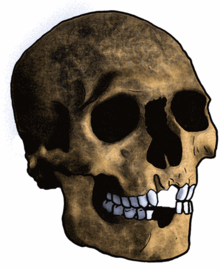Mechta-Afalou

Mechta-Afalou, also known as Mechtoid or Paleo-Berber, are a population that inhabited parts of North Africa during the late Paleolithic and Mesolithic.[1] They are associated with the Iberomaurusian archaeological culture.
Bioanthropology
Mechtoids are believed to have been assimilated during the
Genetics
Iberomaurusian fossils excavated at the Afalou site were found to carry the mtDNA haplogroups
Iberomaurusian fossils excavated at the
Loosdrecht et al. (2018) analysed genome-wide data from seven ancient individuals from the Iberomaurusian Grotte des Pigeons site near
Iosif Lazaridis et al. (2018), as summarized by Rosa Fregel (2021), contested the conclusion of Loosdrecht (2018) and argued instead that the Iberomaurusian population of Upper Paleolithic North Africa, represented by the Taforalt sample, can be better modeled as an admixture between a Dzudzuana-like [West-Eurasian] component and an "Ancient North African" component, "that may represent an even earlier split than the Basal Eurasians." Iosif Lazaridis et al. (2018) also argued that an Iberomaurusian/Taforalt-like population contributed to the genetic composition of Natufians "and not the other way around", and that this Iberomaurusian/Taforalt lineage also contributed around 13% ancestry to modern West Africans "rather than Taforalt having ancestry from an unknown Sub-Saharan African source". Fregel (2021) summarized: "More evidence will be needed to determine the specific origin of the North African Upper Paleolithic populations."[8][9]
Martiniano et al. (2022) later reassigned all the Taforalt samples to haplogroup E-M78 and none to E-L618, the predecessor to EV13.[10]
D’Atanasio et al. 2023 found that Iberomaurusian-like ancestry was characterizing for the "ancient Green Saharan" population about 12,000-5,000 years ago, and that modern-day Fula people derive around 30% of their ancestry from this ancient Saharan population, which was "modeled as a sister group of ancient Northern Africans, or alternatively, as an outgroup of all the “Eurasian-ancestry” enriched groups".[11]
Language
MacDonald (2003) states: "When one considers the African populations of the Terminal
Blench (2019) states: "The linguistic affiliation of the North African forager populations who came south is difficult to establish as they probably represented a language phylum or phyla now vanished…These populations are called ‘Paleoberber’ in the literature, but there is no evidence they spoke a language in any way connected with
See also
References
- ISBN 9780870742163.
- ^ P. Sheppard; D. Lubell (1991). "Early Holocene Maghreb prehistory: an evolutionary approach" (PDF). Sahara. 3: 63–9. Retrieved 4 August 2016.
- PMID 18701936.
- S2CID 4490910.
- ^ PMID 29545507.
- ^ "E-M35 YTree".
- S2CID 226555687.
- ISBN 978-90-04-50022-8.
However, a preprint from Lazaridis et al. (2018) has contested this conclusion based on new evidence from Paleolithic samples from the Dzudzuana site in Georgia (25,000 years BCE). When these samples are considered in the analysis, Taforalt can be better modeled as a mixture of a Dzudzuana component and a sub-Saharan African component. They also argue that it is the Taforalt people who contributed to the genetic composition of Natufians and not the other way around. More evidence will be needed to determine the specific origin of the North African Upper Paleolithic populations, but the presence of an ancestral U6 lineage in the Dzudzuana people is consistent with this population being related to the back migration to Africa.
- S2CID 91380277.)
Moreover, our model predicts that West Africans (represented by Yoruba) had 12.5±1.1% ancestry from a Taforalt related group rather than Taforalt having ancestry from an unknown Sub-Saharan African source; this may have mediated the limited Neanderthal admixture present in West Africans. An advantage of our model is that it allows for a local North African component in the ancestry of Taforalt, rather than deriving them exclusively from Levantine and Sub-Saharan sources. ... and Taforalt, can all be modeled as a mixture of Dzudzuana and additional 'Deep' ancestry that may represent an even earlier split than the Basal Eurasians.
{{cite journal}}: Cite journal requires|journal=(help - PMID 35084493.
- S2CID 265356320.
- S2CID 163304839.
- S2CID 197854997.
